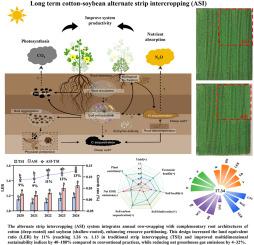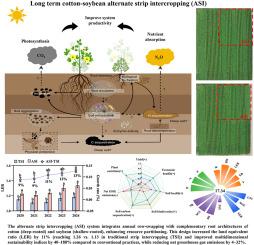时空多样化使棉花-大豆可持续生产具有更高的产量和更少的排放
IF 10
1区 环境科学与生态学
Q1 ENGINEERING, ENVIRONMENTAL
引用次数: 0
摘要
传统的单一栽培和静态间作制度加剧了土壤退化、温室气体排放和产量停滞,无法协调生产力与环境可持续性。为了应对这些挑战,我们开发了一种新型的交替带状间作(ASI)系统,该系统将棉花和大豆之间的年度行交换整合在一起,利用时空多样化来优化资源利用和土壤功能。通过在华北平原进行的为期6年的田间试验,我们验证了ASI在提高生产力、土壤健康和氮循环效率的同时减少温室气体排放的假设。与单作相比,ASI通过改善光、水和养分分配,使棉花和大豆的产量分别提高了28%和21%,达到1.26的土地当量比,超过了传统间作(1.13)。土壤有机碳增加了21%,这是由微生物重组(例如,丛枝菌根真菌定植增加83 - 87%)驱动的,这增强了团聚体稳定性和养分保留。重要的是,ASI通过优化氮循环和微生物抑制反硝化,将产量增益与排放强度解耦,减少了18 - 23%(棉花)和6 - 11%(大豆)的累积N2O排放量。经济效益比传统系统提高24 - 122%。综合农艺、生态和社会经济指标的多维可持续性指数显示,与传统做法相比,ASI改善了40 - 188%。这些结果是由互补的根构型和根际相互作用驱动的,这些相互作用促进了碳固存和氮利用效率。该系统通过展示实现气候适应型农业生态系统的途径,支持可持续发展目标2(零饥饿)和13(气候行动)。在研究的温带环境中,ASI调和了产量与环境的权衡,为类似农业生态系统的清洁生产提出了可扩展的方法。本文章由计算机程序翻译,如有差异,请以英文原文为准。


Spatiotemporal diversification enables sustainable cotton-soybean production with enhanced yield and reduced emissions
Conventional monoculture and static intercropping systems exacerbate soil degradation, greenhouse gas emissions, and yield stagnation, failing to reconcile productivity with environmental sustainability. To address these challenges, we developed a novel alternate strip intercropping (ASI) system that integrates annual row-swapping between cotton and soybean, leveraging spatiotemporal diversification to optimize resource use and soil functionality. Through a six-year field experiment in the North China Plain, we tested the hypothesis that ASI enhances productivity, soil health, and nitrogen cycling efficiency while reducing greenhouse gas emissions. Compared to monoculture, ASI increased cotton and soybean yields by 28 % and 21 %, respectively, achieving a land equivalent ratio of 1.26—surpassing traditional intercropping (1.13)—through improved light, water, and nutrient partitioning. Soil organic carbon rose by 21 %, driven by microbial restructuring (e.g., 83–87 % higher arbuscular mycorrhizal fungi colonization), which enhanced aggregate stability and nutrient retention. Critically, ASI reduced cumulative N2O emissions by 18–23 % (cotton) and 6–11 % (soybean) via optimized nitrogen cycling and microbial suppression of denitrification, decoupling yield gains from emission intensity. Economic returns increased by 24–122 % over conventional systems. Multidimensional sustainability indices, integrating agronomic, ecological, and socioeconomic metrics, revealed 40–188 % improvements under ASI compared to conventional practices. These outcomes were driven by complementary root architectures and rhizosphere interactions that fostered carbon sequestration and nitrogen use efficiency. This system supports Sustainable Development Goals 2 (Zero Hunger) and 13 (Climate Action) by demonstrating a pathway toward climate-resilient agroecosystem. Within the studied temperate environment, ASI reconciles yield-environment trade-offs, suggesting a scalable approach for cleaner production in similar agroecosystems.
求助全文
通过发布文献求助,成功后即可免费获取论文全文。
去求助
来源期刊

Journal of Cleaner Production
环境科学-工程:环境
CiteScore
20.40
自引率
9.00%
发文量
4720
审稿时长
111 days
期刊介绍:
The Journal of Cleaner Production is an international, transdisciplinary journal that addresses and discusses theoretical and practical Cleaner Production, Environmental, and Sustainability issues. It aims to help societies become more sustainable by focusing on the concept of 'Cleaner Production', which aims at preventing waste production and increasing efficiencies in energy, water, resources, and human capital use. The journal serves as a platform for corporations, governments, education institutions, regions, and societies to engage in discussions and research related to Cleaner Production, environmental, and sustainability practices.
 求助内容:
求助内容: 应助结果提醒方式:
应助结果提醒方式:


